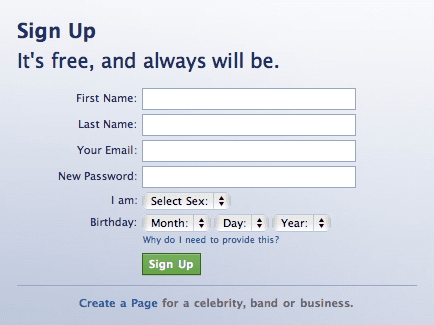By the summer of 2009, Facebook came with a few new profiles: personal pages, community pages, and public profiles. The three are distinct, and even within the public profiles, one has a number of choices about the kind of public profile one wishes to establish. There were some issues (surprise!) when the features were first added, but by now many of the kinks have been smoothed out. A little research before you start clicking can go a long way though, because if you start your page in a ‘wrong’ category, all you can do is delete that page and start over, an unpleasant prospect. But please read on and hopefully we can clarify some of the jargon.
The first decision is whether to create only a personal page or go on to establish an organization/public page. The rub is, the person who establishes and monitors a business’s (or a band’s or a charity’s…) page must have his or her own personal account first – even if he or she does nothing with it. So one must fill out the form seen in the screengrab to the left. But really: if you are reading our blog, you are likely aware of this procedure, if not one of the 500 million folks on it right now.
Once your personal account is set up, sign out, go back to the FB homepage, and click “Create a page” in the small print below the sign up fields. You will sign back in with your own personal account, but the good news is that one need not advertise the organization page one is monitoring with the personal page on which one is posting pictures of the Sunday afternoon barbecue.

Your organization will likely want an 'Official Page'
Here is where the right decisions will save headaches later. Though a community-action group might be tempted to go with a “Community Page,” this feature was added in an attempt to siphon off people who were making open pages about an idea or a product for which the people in question had no legal status to speak for. Thus, community pages are rather like public bulletin boards for a topic. It would be cool if your company’s point/idea became popular, but your company will really be just one of millions who might (not) post to it. Not much messaging control, in other words.

Choose wisely...
But once we move to the left of the window, still further choices need to be made. Not difficult ones, but ones that are set in e-stone (unless or until you delete the account altogether). It is worth clicking on each of the three ‘radio buttons’ to reveal their relevant drop-down menus to see which category best fits your organization. Be sure to give the page a name, presumably the one of your organization (or a tag line?). You also must click the box denoting your rights and responsibilities to speak for the organization in question. Remember though: to edit this page later one must sign into FB with one’s personal account set up earlier.
Once the page is created, the options are rather like – but not exactly like – one’s personal page. Along the way, you had to click that box stating that you had the right to speak for the organization whose page you have just set up. So any information here needs to be about the organization, not you the person. Not unlike ou the person, though, find a balance between the company’s proprietary information and posting so little on one’s page that it looks like the company does not want to reach out. Like your personal page, your company can start seeking individuals and other organizations within the network to create and share ‘Friends.’ Thankfully, in this instance, FB seems to have taken the ‘opt-in’ approach. Your personal page is not linked to this page until you go to your personal page and ask to link them. You might not want to do that… Same for Twitter: be sure the link is to the company’s account as well, not yours.
It is at this point we must part company, as each organization has its own needs and ambitions with getting established on Facebook. We hope this little primer on how to set up the kinds of pages/accounts available has proved helpful. Tomorrow our week-long series on Facebook will wind down with a look at how the FB phenomenon has affected businesses and not-for-profits. Please click back!

